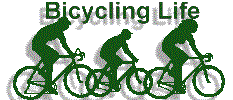By John Andersen
In the springtime, concerns turn toward the horde of child-cyclists turned loose upon
the streets of cities and towns across the country. In many communities, concerned
agencies ban together to hold one day of training for young bicycle drivers in the hope of
preventing accidents.
Thus is born the Bike Safety Rodeo. These events are, in many case the only
opportunities to educate parents and children about the safety aspects of riding a bicycle
on streets and roads. The goal is to empower young cyclists with a minimal set of skills
for on-road riding. To teach them the a small subset of the rules of the road sufficient
to keep them safe. How well this works is open to debate.
What is a Rodeo
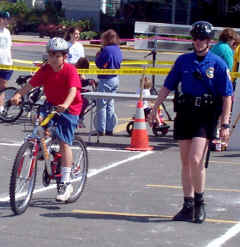 A Bike Rodeo is usually a bicycle safety clinic featuring bike
safety inspections (and optionally quick tune-ups), and a safety lecture about the rules
of the road (10 to 15 minutes). This is followed by a ride on a miniature "chalk
street" course set up in a parking lot where young cyclists are shown where and how
to apply the rules. Optional activities include Helmet fitting, prizes and drawings, and
in some cases commercial activities such as booths set up by bike shops etc. A Bike Rodeo is usually a bicycle safety clinic featuring bike
safety inspections (and optionally quick tune-ups), and a safety lecture about the rules
of the road (10 to 15 minutes). This is followed by a ride on a miniature "chalk
street" course set up in a parking lot where young cyclists are shown where and how
to apply the rules. Optional activities include Helmet fitting, prizes and drawings, and
in some cases commercial activities such as booths set up by bike shops etc.
The main focus of a bike rodeo is Cycling Safety for young cyclists, ages kindergarten
to 14 or so.
Rodeos are usually held a week or two after school is out for the summer, perhaps
earlier in warmer climates where kids start biking to school earlier in the year. They are
usually held on a Saturday in a large parking lot where a fairly large chalk course can be
laid out with simulated streets, intersections, crosswalks and stop signs.
The participants are usually escorted through the course by knowledgeable adult
cyclists who point out hazards, safety tips, and explain how to apply the rules of the
road that were mentioned in the lecture.
Quite often this walking chalk talk is best handled by local Police officers, either
assigned or volunteers, who are familiar with bicycle safety issues and who are cyclists
themselves. Many cities have Police Bicycle Patrols. These officers are frequently
interested in participating in such events, because they see accidents, (and attend the
victims) resulting from ignorance of cyclists.
Corny Name?
The term "Bike Rodeo" may seem kind of corny, but it has a long history, and
it is attractive to the age group to which it is targeted. The Kiwanis clubs have
historically sponsored these events over several years. Lately there has been trend for
more bicycle-knowledgeable organizations getting involved.
You would be hard pressed to get many kids to attend a safety lecture if that was all
there was to it. Having the chalk course adds a lot of fun for the kids and condenses a
lot of training situations into a very small place where even the youngest cyclists can be
given some training in safety. "Rodeo" is a lot more attractive than
"clinic" or "lecture" or "seminar" to the age group in
question.
45 Minute EC Course?
Most kids are through the entire process in 45 minutes or so. In that time, they can be
told, then shown and even practice the key items of effective cycling pertinent to their
age group. This is clearly not meant to be an Effective Cycling course.
They will learn about blind corners, stopping at stop signs, staying off sidewalks,
yielding to pedestrians, avoiding the door-zone, intersections, crosswalks and driveways.
The repetitive nature of the course - lecture followed by "doing" and some
take home material, has proven to be a very good teaching method in other fields.
The students will not be practicing in rush hour traffic, or making left turns from a
multi-lane arterial. They will not learn the proper lane positioning (keep to the edge of
the road is almost always the message), lane changes, or instant turn techniques. Nor will
they be learning much about traffic flow, and how it affects them and how to interact with
motor vehicles.
Because of the artificial nature of bike rodeos on chalk streets, and the short time
period allowed, these skills are not covered. Only the basics of signs, signals, stops,
and some hopeful instruction on defensive cycling. Still, it's better than nothing and
nothing is exactly what is offered in most towns to children of this age.
Age Groups
The age group that bike rodeos try to reach are those who are just beginning to use
bikes to ride around the neighborhood in quiet residential areas up through the early
teenage years where the bicycle serves as the principal means of transportation around
town.
It’s important to have a course large enough to include situations for both ends
of the age range. This might include some course segments that are only offered to older
riders – such as actual on-street segments.
Stations and Activities
To keep the operation flowing and prevent herds of kids standing around doing nothing,
it is important to organize the event with discrete "stations" through which the
participants are guided. The stations are best laid out in an open area marked off with
rope or ribbon, which guides the participant from one station to the next.
The layout should be such that the participants will not be distracted by a prior
station, and always looking forward. This means refreshments at the END, so you don’t
have kids trying to ride a bike with a soft drink in their hands. Often the stations can
be laid out in a line, but if the area won’t accommodate this, use a serpentine
arrangement with ribbons to guide participants from one station to the next.
It's also important to have all parental matters (registration, permission slips, fees
etc) handled at the first station so that the kids may proceed on their own through the
other stations. It is often desirable to have the parents accompany the kids through each
station, and indeed, this is the norm for the youngest children. It is helpful to have the
parents along so that bicycle-fit, or helmet adjustment can be explained to the parent as
well as the participant. About age 10 or so, the kids would rather do it themselves, and
may actually learn better alone.
There is no need to separate kids by age group, until they reach those segments that
are specific to certain groups. For example, a good "rules of the road"
presenter can hold both 6 year olds and 14 years olds attention for the brief time need to
present the rules.
The lecture station is the only station where having small groups (3 to 8) is normal,
as most other stations and activities are one on one.
So what are the typical stations, and what does a Rodeo hope to accomplish at each?
Let’s present them each in turn. The links associated with each station point to
resources for those activities.
Registration
At the registration station you will be signing up each participant and obtaining the
permission signatures from the parents. The registration form should also bear the waiver
of liability. These are necessary items. The registration serves to document the event,
and justify next year’s event. It also serves as a semblance of legal protection in
the event of a fall.
The registration forms should also contain a "permission" section where a
parental signature is collected. If there are special/optional segments of your Rodeo
(such as an "on-Street" training ride) make sure there is a separate checkbox
for that item and a place for parents to separately initial or sign.
If there are drawings or door prizes tickets for these are also best given out at the
registration stations. The two-part tickets with numbered stubs are best for this.
Printed material for the parents concerning bike safety issues should be made available
at the registration station. (Important: try not to send the kids through the event with
papers in their hands).
Finally a checklist form is attached to the bike for the bike inspection station. Bikes
judged unsafe are not allowed to participate in the event. This form is used for that
purpose as well as a vehicle to get a check list back to the parents about needed repairs.
An example of a form that serves as a single all-in-one, Registration, permission form,
waiver, safety checklist can be downloaded here (Microsoft
Publisher format). If you don't have publisher and just want to view a sample a PDF version is available here. This form has a tear-off
that is retained at the registration table with name/address/age information for the Rodeo
records. The other part (the largest piece) carries the signatures, permissions, and
waiver on one side and the checklist on the other. That part is attached to the
participant’s bike, and goes through the entire course and is marked at each station
as necessary. Note: in the event of an accident, no matter how slight, this tag
must be taken and kept by an event official. Another tag may be substituted
if the participant is able to continue through the other stations, but in no event should
the tag bearing signatures be returned to the child or parent after any kind of accident.
This is your only proof of waiver and permission.
Bike Inspections
| After registration, the kids wheel their bikes to the inspection stations.
There are usually four sub-stations in the bike inspection section. These are best if
staffed by knowledgeable cyclists with mechanical abilities. Bike club members or
professional "wrenches" from local bike shops are great candidates. The
Substations include:
- A – Air and Tires
- B – Brakes
- C – Cranks and Chain
- F – Frame and Fit
|
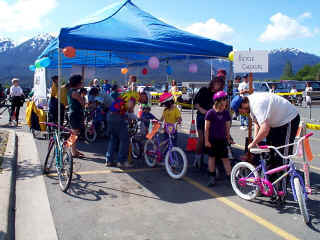
Inspections occur right after registration.
|
A detailed list of all the items checked at each station can be found HERE. Downloadable PDF version here.
Depending on the staffing available and the number of kids attending you may choose to
do quick tune-up tasks at these stations. Normally the only adjustment you will have time
to do is adjust seat height. However if you have enough mechanics around, set up a couple
of bike repair stands out of the traffic flow and triage the bikes
through the inspection station.
By "Triage" I mean that the inspection stations identify bikes that:
- Have no significant problems and can proceed
- Have serious problems that can’t be corrected here – and may not be allowed on
the chalk course – these bikes are "Flunked" and you waste no more time on
them. Refer these bikes to a competent bike shop. Be prepared to explain to the parents
why this decision was made, (If possible, try to provide loaners for these kids).
- Have easily repairable problems, which fit within the scope of what you are prepared to
handle at the Rodeo. Sideline these bike to the repair stands so as not to hold up the
queue. It's best to have bike shop pro’s do any significant wrench work as you assume
a certain liability with every thing you do to a bike.
For most of the substations, volunteers from bike clubs or other experienced cyclists
can do a more than adequate job of inspection. These people should be prepared to explain
to young riders and their parents how to take care of the bike and what needs fixing. They
should have knowledge about good bike shops in the area.
This is not the place to harangue the parents about "dime store bikes". In
fact, just the opposite is true. Bikes that look to be in good shape should get verbal
compliments. Try to boost the child’s sense of pride in his/her "wheels"
and encourage good care of the bike.
Note that frame and fit sub-station most frequently finds young kids riding bikes too
small for them where their knees are almost bumping their chins. Therefore, this
substation should be staffed by an experienced cyclist or bike shop employee, with
knowledge of the aspects of bike fit. Have due regard for the age of the child and the
child’s degree of insecurity on high seats. Often the parents (if knowledgeable about
bikes at all) have been trying to talk the kid into having the seat raised, but such
raises scare the child. Often an outside "expert" (in the child’s eyes) can
often talk the most timid child into raising the bike seat. If so, small raises ¼ to ½
an inch are all that is advisable. Explain to the parent to do it again in a week or two.
It’s more important for young cyclists to be confident than it is for them to be
efficient.
Defects on the bikes that should be taken care of should be noted on the form attached
to the bike. The kids are expected take this home and hopefully the parents will get the
bike to a bike shop.
Rules of the Road
| At the Rules of the Road station the object is to get the basic rules
covered before the kid’s eyes glass over. An animated speaker is needed. You need
someone knowledgeable about cycling, and how bicycles fit into traffic. This is NOT the
place for a "fear talk". This is not the place where the principal message is
"wear a helmet".
The age group usually in attendance is already starting to ride around the
neighborhood. But, except for the 13-14 year olds, they are unlikely to be in high traffic
situations. This station does not need to cover all the fine points of vehicular cycling,
and certainly does not need to cover all the find points of the law. There is a limit to
what an 8-year-old can absorb. The Rules station needs to explain very simple rules that
kids of any age can learn: |
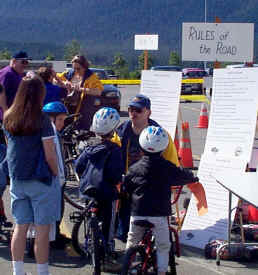
Alask State Bike/Ped Coordinator volunteers at "Rules of the Road"
Station
|
- Stop at Signals and Stop signs
- Stop, or slow to a crawl before entering any roadway or at blind intersections
- Slow vehicles keep right
- Ride with traffic, not against it
- Signal your turns (have them practice…)
- Ride predictably, no swerving or curb jumping
- Stay off the sidewalks – adjusted for local laws etc.
- Most importantly – just Pay Attention!
Having handouts for the parents is also a good idea. Don’t burden the kids with
handouts at this station, give them to parents and make them available at the end of the
course.
Helmet Fit
Whatever you personally believe about helmets (and here at Bicycling Life we generally
avoid the issue), you will find that no one will sanction a bike rodeo where helmets are
not advocate to some degree. If you are not a fan of helmets you would be best to accept
the fact that they are going to be part of any bike rodeo that is expected to garner
support from a wide range of agencies, because your bike rodeo will need that support.
It is CRITICALLY IMPORTANT that helmets do NOT come across as
the principal safety lesson of the Rodeo. That statement does not represent my political
belief about helmets, it just a statement of facts:
- Parents, some of whom know very little about cycling, should never be given the
impression that putting a helmet on a kid satisfies their duties to keep their children
safe.
- The principal message of Bike Rodeos is the Rules of the Road as the principal avenue
toward bike safety.
- Helmets are a very poor substitute for common sense traffic smarts, which, even
6-year-olds, can master.
- The idea is FIRST to avoid a collisions, and somewhere near the tail end of the list
(after giving up all hope of avoiding a crash) to ameliorate collisions. Helmets work only
on that latter category.
The kids attending are in the age groups where they fall off the bike occasionally (ok,
somewhat more than occasionally), and could probably benefit from helmet use even if
teaching the rules of the road were wildly successful.
So, helmet use must be soft-peddled as a safety measure, while at the same time
required to participate, for liability reasons if nothing else.
As such, helmet fit is important, as most kids don’t wear them correctly. Use
these resources for the staffers of the helmet fit. Kids tend to wear the helmet slid way
back on the head rather than on top.
Some bike rodeo’s give out helmets (if funding allows). At our Rodeos we have done
that in the past, but in recent years, we just give the kids another ticket if they bring
their own helmet (and therefore another chance to win prizes).
The "Chalk Streets"
The Fun Part!
| Kids love the miniature streets. I’ve seen kids go through the
stations twice just to get to the Chalk Streets section again.
Here is a sample
layout you can download. At our Bike Rodeo, we
have had good cooperation from the local Police Department (Juneau
Police Department) in having Bike Patrol Officers
take kids through the Chalk Streets one on one.
The officers always wear their Bike Patrol uniforms and have Police Bikes close by
(red lights and all), but they always accompany the participants on foot through the
course pointing out how to apply the rules of the road. |

Juneau Alaska Bicycle Police volunteers take each participant through the course one-on-one.
Bus provides "blind corner". Pedestrian and dog peridoically cross in
front of riders.
|
Hoofing up and down a large parking lot for four hours can be a lot of hot
work, make sure someone offers these guys and gals a cold drink now
and then.
Each officer picks up the next rider at the "Driveway". After a short chat to
build rapport, the officer takes the student bike driver down the "street",
through the "intersections" over the "railroad tracks" etc., all the
while point out how to apply the rules of the road, and things to watch out for.
This is a win, win system. The kids get some personal attention from "Officer
Bob" in a positive situation. Here is an authority figure helping them to ride a bike
and giving them tips and advice and praise. And the officer has a bike too!
The police send the message to parents (and drivers) that cyclists belong on the streets. The kids
get the message that they have to follow the rules of the road just like cars. It works.
It’s popular. Kids dig it!
At the end of the ride, we have the officer sign the registration tag attached to the
bike, usually giving a passing grade. The registration slip now has a bike inspection
report as well as a student driver report.
If you can’t solicit cooperation from your local police you can still put on a
rodeo with bike club members, firemen, etc. Then start working on those cops!
Post-Ride Booths
Many of the agencies that help in the planning, organization and funding of the Bike
Rodeos have a message to get across. Most of these organizations are concerned with child
well being and health. Some are State/County/City agencies, others are national
organizations such as the Boy Scouts and Girl Scouts.
These agencies may have safety material they want to present (government agencies), or
they may want to recruit members (scouts and bike clubs), or they may have something to
sell (bike shops).
You may want to have a prize table where participants can redeem their tickets after
each drawing. At our last Rodeo we were able to give away 6 bikes due to a local store
having some "extras". Smaller items like locks and helmets, bike bags, and
gloves can also be attractive.
Commercial Booths
Some people may object to commercial activity on the site, but as long as it is focused
on bicycle safety and these organizations contributed something to the planning or
execution of the rodeo, my personal feeling is that more is better.
Bike Shops
Bike Rodeos are a natural venue for bike shops. They may want to have a booth to sell
bike supplies (water bottles, locks, pumps, tires) and safety gear (helmets, gloves). As
an organizer of your Rodeo, you should try to solicit more than just a commercial booth
from a bike shop. They should supply a mechanic and a bike repair stand to the inspection
stations. Don’t expect them to perform major repairs on bikes all day for free. Allow
them to hand out advertising and promo items.
Refreshments
If you get warm weather for your Rodeo you will want cool refreshments available. If
local stores wants to donate soft drinks they ought to get a mention on the list of
sponsors.
If you can find a Good Humor vendor (or similar company licensed to vend on the street)
it will add to the event. Have enough consideration not to invite refreshment vendors onto
the site if you are using the parking lot of a commercial establishment selling similar
refreshments.
Innovative Additions
There is no set pattern for Bike Rodeos and you can add items suitable to your area. If
you have an active bike club that hold’s races you may want to see if you can have
them put on some "sprint" races that terminate or originate at the Rodeo. (Bear
in mind that the message the Rodeo is bike safety, and many racing clubs have a less than
glowing reputation for adherence to the rules of the road.)
On Road Training
| In our last Rodeo, we were able to present an actual on-street (pavement
– not chalk) training ride to participants 10 years and older with parental
permission. This was suggested at early planning meetings, and the Police officers
detailed to Rodeo took the idea to the Chief and basically went to bat for
the Rodeo. The Chief agreed.
We had a ¾ mile route where a mounted Bike Patrol Officer (this time on bike, not on
foot) took students one-on-one onto an urban highway, through a signalized intersection,
past several busy commercial driveways and residential street intersections. |
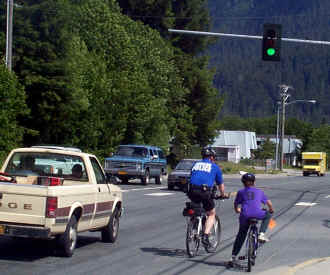
JPD Bike Officer and pupil start off as the light changes in urban on-street training ride.
Ask Officers to warn about dangers of the Right Hook at
intersections like this.
|
The return trip required a vehicular left turn back onto the highway, more
intersections and finally a pedestrian crossing at the same lights they had previously
navigated on the bike.
The Police Department took a certain risk in this endeavor. The idea of a kid involved
in an accident while under the supervision of a police officer has "law suit"
written all over it. But the course chosen had wide shoulders, good sight lines and was as
safe as you could reasonably expect of any city street. (Which, after all, is pretty
darned safe, especially with everyone trying to follow the rules of the road).
Several parents remarked that the street ride was the main reason they brought their
kids to the Rodeo. It was a total success, and one we look forward to repeating next year.
Off Road Course
Bike safety includes more areas than just the street. If your location lends it self to
some off-road trails or bike paths these might be incorporated into your Rodeo for more
realistic training. After all, bike paths generate a lot of accidents, yet most young
cyclists (and their parents) believe that they are safer there than in the streets.
Off road hazards that younger riders are likely to encounter in their first summer of
unsupervised cycling include rough down-hill runs (and the resultant braking
induced
"endos"), mud, loose sand, water, and similar terrain.
Bike Security
In cities with high theft problems you might include some demonstrations on bike
security in your Rodeo. You can demonstrate the proper way to lock a bike, where to lock
bikes, how to carry locks, what kinds of locks work best, etc.
Expecting Miracles
Do Bike Rodeo’s really work? Do they make any lasting impression on
young cyclists? Do they reduce accidents?
At this time there does not appear to be sufficient evidence to make any great claims
for the efficacy of bike rodeos. There are no studies that I know of which document the
success or failure of these programs. Such a study could be as simple as emergency room or
ambulance check-box asking child-cyclist accident victims if they ever attended a bike
rodeo. But don’t hold your breath, there is enough paperwork in the medical arena
already. On the other hand, they seem to have enough time to ask if the kid was wearing a
helmet….
Many competent vehicular cyclists have reservations about the idea of bike rodeos. The
principal concern is usually that "Chalk Streets" do not translate well in a
child’s mind to pavement with automobile traffic. Curbs, gutters, potholes, stop
signs, and, yes, real motor traffic are all missing. So are the dynamics of real
intersections, real driveways and other road users.
Sure the course is fun. But "Fun" is not the point. The real lesson may be
lost in the fun.
This may be a somewhat uncharitable characterization of a well-meaning program. Kids
have an active imagination and translate much more of the pretend world to the real world
than adults realized.
Still, many cycling and safety organizations have abandoned the idea of "Chalk
Street" rodeos altogether in favor of on-street training, usually in calm
neighborhoods near schools.
According to Eve DeCoursey, Executive Director of Hawaii Bicycling League's "BikeEd Hawaii"
Program
"We do NOT attempt to duplicate traffic situations by drawing intersections on
paved playgrounds. We have found simulation to be minimally effective when teaching
children about proper behavior on roads and interaction with traffic. We take the children
(who have been deemed to have good enough bike handling skills) RIGHT OUT ONTO THE
SECONDARY ROADS adjacent to their school."
| Hawaii’s success in getting bicycle education into the schools is a
fine example for other areas. Other school districts combine cycling into physical
education, where, unfortunately, it is often taught by Phys-ed majors with little or no
formal cycling training. |
"Nobody ever died
from not knowing how to play flag football. Yet we spend tax money teaching kids
its
nuances in gym classes, while bicycle safety is still foreign to most school
curriculums." — Don Cuerdon (quoted in The Quotable Cyclist edited by Bill
Strickland, pg. 164.) |
America is a risk-avers nation, and public schools are perhaps the most risk-avers of
institutions. Public school administrators have succumbed to the popular myth of dangers
of bicycling. The fact that football is 38 times more likely to result in a hospital visit
than is cycling seems lost on them.
As a result, other than in a few innovative locations such as Hawaii, there is no
formal training available for cyclists of grade school age.
Bike Rodeos are most kids' first and only exposure to bicycle safety training. In the
absence of anything better, a Bike Rodeo is fairly easy to organize, and relatively
inexpensive to execute. A small group of 6 to 10 interested parties can generally organize
a Rodeo.
In most cases, rodeos are the only event you will ever get the parents to
attend, if for no other reason than that rodeos are typically not
hosted by schools. Parents can't just send the child to school and wash their hands of
bike education. Parents have to bring their children to rodeos. Don’t overlook
this opportunity. Parents constitute a large percentage of "those motorists"
that cyclists share the road with every day. These drivers should be encouraged to reflect
upon the fact that soon their child will be out on those same roads.
If there is no formal bicycle training program in your schools, you might try and
organize a Bike Rodeo. By getting community agencies and organizations thinking
about bike safety training you are building a defacto consensus that such training is
needed. By having several hundred kids show up, parents in tow, you are building a
constituancy for better and sider coverage. When a disbelieving school board hears
from a convinced Chief of Police the odds of getting a formal program introduced can only
be improved.
|
